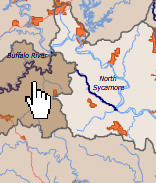The Clean Water Act (Wikipedia Article) requires states to develop and maintain water quality standards. The Arkansas Department of Environmental Quality (ADEQ) uses monitoring data to assess the waters of the state. They are required by section 303(d) of the Clean Water Act to publish an Inventory of Impaired Waterbodies (IIW). They are required by section 305(b) of the Clean Water Act to publish an Integrated Water Quality Monitoring and Assessment Report (IWQMA).
Clean Water Act Section 303(d) - Inventory of Impaired Waterbodies
This inventory generated by ADEQ is submitted to the Environmental Protection Agency (EPA) for approval. It contains all of the sections of streams, rivers or lakes that are not meeting Arkansas water quality standards found in ADEQ's Regulation 2. These inventories are available from ADEQ as PDF files. We have combined and converted them into Excel files. Furthermore, we have organized them by watershed on individual watershed pages, and you can see them mapped with the Interactive Watershed Viewer.
- 2008 303(d) List (PDF, 0.2 MB)
- Maps of 2008 303(d) Impaired Streams (NPS & PS) for Priority Watersheds
- 2006 Proposed 303(d) List (PDF, 0.2 MB)
- 2004 303(d) List (PDF, 0.7 MB)
- 2002 Proposed 303(d) List (PDF, 0.6 MB)
- Compiled Inventory of Impaired Waterbodies, 2004-2008 (Excel)
- Find Impaired Streams in Your Watershed
- View Impaired Streams with Interactive Watershed Viewer
Clean Water Act Section 305(b) - IWQMA Report
This ADEQ report includes the inventory of impaired waters along with the location of monitoring stations, how waterbodies were monitored or evaluated, Arkansas' prioritization methodology for TMDL development, and a discussion of each ADEQ Planning Segment (which may include one or more 8-digit HUCs).
- 2008 305(b) IWQMA Report (PDF, 27.9 MB)
- 2004 305(b) IWQMA Report (PDF, 6.5 MB)
- 2002 305(b) IWQMA Report (PDF, 8.5 MB)
Total Maximum Daily Loads
A Total Maximum Daily Load is a written document showing how the State or EPA determined how much to reduce 'point source' (Wikipedia) and 'nonpoint source' (Wikipedia) pollution in order to keep an impaired section of stream, river or lake from exceeding Arkansas water quality standards found in ADEQ's Regulation 2.
- ADEQ Partial List of Arkansas TMDLs
- EPA Partial List of Arkansas TMDLs
- ArkansasWater Compiled List of Arkansas TMDLs
- TMDL Development Process (Flow Chart)
- Find TMDLs in Your Watershed
Arkansas Groundwater
Don't forget about groundwater! Making up on average 20% of the world's fresh water supply, groundwater (Wikipedia) is often used when freshwater is not available. In Arkansas, agriculture places the biggest demands on groundwater.
- USGS Ground Water Atlas for Arkansas, Louisiana and Mississippi
- USGS Groundwater Stations in Arkansas (Real-time table levels)
- ANRC Groundwater Protection and Management Programs
- ANRC Groundwater Publications
- Pesticide Management Plan for Groundwater - Arkansas State Plant Board
Do Something!
It is easy to get lost in the bureaucracy, but there are other ways to learn about and improve the waterbodies of Arkansas. Explore land management practices, water-related programs and more on this site. The links below will take you to the websites of other agencies.
- ADEQ Online Complaint Form
- ADEQ Water Quality Standards Review
- Arkansas Game & Fish Commission - Stream Team Program
- Arkansas Department of Health - Drinking Water Information
- Arkansas Water Resources Center - Testing Fees & Information for 2009 (PDF)
- Arkansas Watershed Advisory Group - List of Local Watershed Groups
- Environmental Protection Agency - Drinking Water Information
- United States Geological Survey - Arkansas Water Science Center


